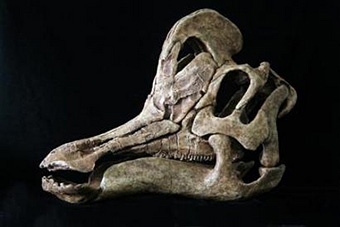
|
 |
 |
 Editorials | Environmental | February 2008 Editorials | Environmental | February 2008  
Crested "Beach Bum" Dinosaur Found in Mexico
 Will Dunham - Reuters Will Dunham - Reuters
go to original


| | Undated image shows the reconstructed skull of the newly discovered dinosaur Velafrons coahuilensis. (Gaston Design Inc./Reuters) | | |
Seventy-two million years ago, a dinosaur with a sail-shaped crest on the top of its head lived at a Mexican seashore, munching plants and trying to avoid a cousin of Tyrannosaurus rex.

U.S., Mexican and Canadian scientists on Tuesday announced the discovery of Velafrons coahuilensis, a duck-billed dinosaur that lived about 7 million years before a big rock from space wiped out the dinosaurs and many other creatures.

"Velafrons was probably a beach bum," said paleontologist Terry Gates of the Utah Museum of Natural History and University of Utah.

Its shoreline home was lush, with rivers flowing into a warm, shallow sea, the scientists said.

"It would have been a beautiful time to have been there - very warm, very Mediterranean-like," Utah Museum of Natural History paleontologist Scott Sampson told reporters. "But you've got to worry about the tyrannosaurs out there."

Gates said it is the most complete dinosaur ever found in Mexico. He said the scientists in recent expeditions also found a number of other dinosaurs. The fossilized remains of Velafrons were found in rugged, dry terrain in north-central Mexico in the state of Coahuila, near the city of Saltillo.

Sampson said the discovery is helping open a window into life in the late Cretaceous Period on the southern tip of western North America. The continent at the time was sliced in two at the time by a big inland sea stretching from the Arctic Ocean to the Gulf of Mexico.

'ODD AND FREAKISH'

The creature's head is its most remarkable feature. Sitting on the top of its skull is a hollow crest shaped a bit like the sail of a sailboat. Velafrons coahuilensis means "sailed forehead from Coahuila."

Velafrons and other similar duck-billed dinosaurs had nose bones at the top of the head, with their nasal passages greatly lengthened and running through large crests. "By lengthening its nasal passage, it allowed it to do all sorts of crazy things," Gates said. "It's totally odd and freakish."

Scientists do not know the crest's function, but think it may have helped attract mates. Air blown through the crest passages could made a distinctive trumpeting noise.

The adolescent Velafrons was 25 to 30 feet (7.6 to 9 meters) long, and a full-grown adult would have been 35 feet

long, the researchers reported in the Journal of Vertebrate Paleontology.

Duck-billed dinosaurs were very common at the time. Sampson said Velafrons closely resembled another duck-billed dinosaur called Corythosaurus that lived roughly 3 million years earlier in Alberta, Canada. That one is famous for a head crest that looked like an ancient Greek warrior's helmet.

The Velafrons fossils were found in 1995, but it was not until 2002 that scientists using a jackhammer to get through the hard rock managed to free the skull from the ground.

Velafrons lived alongside small mammals, lizards, turtles and other dinosaurs.

Sampson said the remains of a horned dinosaur related to Triceratops also were found, as was evidence that a big meat-eater related to Tyrannosaurus was on the prowl. Many of the dinosaur bones are covered with fossilized snails and clams, indicating these animals lived near the shore.

(Editing by Maggie Fox and Sandra Maler) | 
 | |
 |



